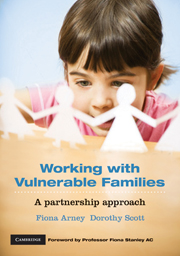Book contents
- Frontmatter
- Foreword
- Contents
- List of figures, tables and boxes
- Contributors
- Acknowledgements
- Introduction
- Chapter 1 Think child, think family, think community
- Chapter 2 Family strengths: an international perspective
- Chapter 3 Harnessing ‘resilience’ when working with children and families
- Chapter 4 Working within and between organisations
- Chapter 5 Family-centred practice in early childhood settings
- Chapter 6 Sustained nurse home visiting with families of Aboriginal children
- Chapter 7 Including fathers in work with vulnerable families
- Chapter 8 Parenting in a new culture: working with refugee families
- Chapter 9 Responding to parents with complex needs who are involved with statutory child protection services
- Chapter 10 Engaging family members in decision making in child welfare contexts
- Chapter 11 Supporting parents whose children are in out-of-home care
- Chapter 12 Using evidence-informed practice to support vulnerable families
- Chapter 13 Spreading promising ideas and innovations in child and family services
- Index
Chapter 1 - Think child, think family, think community
- Frontmatter
- Foreword
- Contents
- List of figures, tables and boxes
- Contributors
- Acknowledgements
- Introduction
- Chapter 1 Think child, think family, think community
- Chapter 2 Family strengths: an international perspective
- Chapter 3 Harnessing ‘resilience’ when working with children and families
- Chapter 4 Working within and between organisations
- Chapter 5 Family-centred practice in early childhood settings
- Chapter 6 Sustained nurse home visiting with families of Aboriginal children
- Chapter 7 Including fathers in work with vulnerable families
- Chapter 8 Parenting in a new culture: working with refugee families
- Chapter 9 Responding to parents with complex needs who are involved with statutory child protection services
- Chapter 10 Engaging family members in decision making in child welfare contexts
- Chapter 11 Supporting parents whose children are in out-of-home care
- Chapter 12 Using evidence-informed practice to support vulnerable families
- Chapter 13 Spreading promising ideas and innovations in child and family services
- Index
Summary
Learning goals
This chapter will enable you to:
Be aware of some of the bio-psychosocial factors and conceptual frameworks which affect child well-being and the capacity of families to nurture young children
‘Think child, think family and think community’ in the way you might work
Appreciate the centrality of ‘relationship-based practice’
Identify the values, knowledge and skills you bring to working with vulnerable families, and reflect on areas in which you may have gaps.
Introduction
Promoting child development, well-being and safety relies upon the ability to ‘think child, think family and think community’. Our knowledge about how biological, psychological and social factors interact to influence the development and well-being of children has never been greater. In a growing number of countries, this knowledge has led to intense interest in early childhood, motivated both by social justice concerns as well as an increasing awareness that the economic future of a society depends on the degree to which its children are healthy, educated and well-adjusted.
Some children are exposed to a volatile mix of poverty, violence, parental mental illness and substance dependence that can erode the capacity of families to nurture their children, causing intense suffering and long-term harm. There are a number of conceptual frameworks and ideas that enable us to understand this, including an ecological model of human development.
Family-centred practice is based on four elements: the centrality of the family as the unit of attention; maximising families' choices; a strengths rather than a deficits perspective; and cultural sensitivity.
- Type
- Chapter
- Information
- Working with Vulnerable FamiliesA Partnership Approach, pp. 7 - 28Publisher: Cambridge University PressPrint publication year: 2010
- 5
- Cited by



